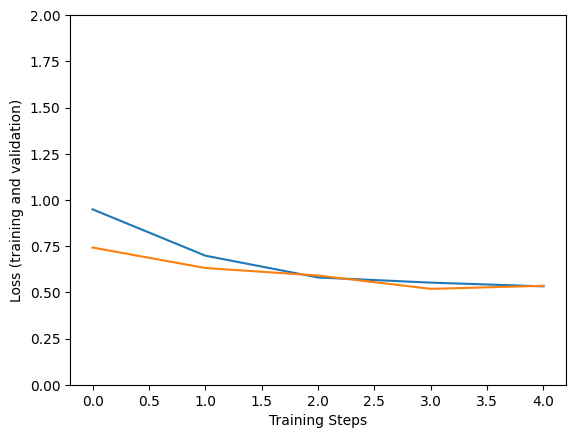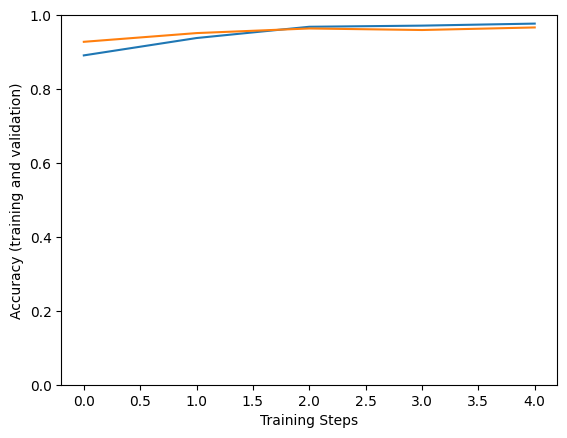 Xem trên TensorFlow.org Xem trên TensorFlow.org |  Chạy trong Google Colab Chạy trong Google Colab |  Xem trên GitHub Xem trên GitHub |  Tải xuống sổ ghi chép Tải xuống sổ ghi chép |  Xem các mẫu TF Hub Xem các mẫu TF Hub |
Giới thiệu
Các mô hình phân loại ảnh có hàng triệu tham số. Đào tạo họ từ đầu đòi hỏi rất nhiều dữ liệu đào tạo được gắn nhãn và rất nhiều sức mạnh tính toán. Học chuyển giao là một kỹ thuật giải quyết vấn đề này bằng cách lấy một phần của mô hình đã được đào tạo về một nhiệm vụ liên quan và sử dụng lại nó trong một mô hình mới.
Colab này trình bày cách xây dựng mô hình Keras để phân loại năm loài hoa bằng cách sử dụng Mô hình lưu trữ TF2 được đào tạo trước từ Trung tâm TensorFlow để trích xuất tính năng hình ảnh, được đào tạo trên tập dữ liệu ImageNet lớn hơn và tổng quát hơn nhiều. Theo tùy chọn, trình trích xuất tính năng có thể được đào tạo ("tinh chỉnh") cùng với trình phân loại mới được thêm vào.
Tìm kiếm một công cụ thay thế?
Đây là một hướng dẫn viết mã TensorFlow. Nếu bạn muốn có một công cụ mà chỉ xây dựng các mô hình TensorFlow hoặc TFLite cho, hãy nhìn vào các make_image_classifier công cụ dòng lệnh đó được cài đặt bởi gói PIP tensorflow-hub[make_image_classifier] , hoặc ít này colab TFLite.
Thành lập
import itertools
import os
import matplotlib.pylab as plt
import numpy as np
import tensorflow as tf
import tensorflow_hub as hub
print("TF version:", tf.__version__)
print("Hub version:", hub.__version__)
print("GPU is", "available" if tf.config.list_physical_devices('GPU') else "NOT AVAILABLE")
TF version: 2.7.0 Hub version: 0.12.0 GPU is available
Chọn mô-đun TF2 SavedModel để sử dụng
Để bắt đầu, sử dụng https://tfhub.dev/google/imagenet/mobilenet_v2_100_224/feature_vector/4 . Có thể sử dụng cùng một URL trong mã để xác định SavedModel và trong trình duyệt của bạn để hiển thị tài liệu của nó. (Lưu ý rằng các mô hình ở định dạng TF1 Hub sẽ không hoạt động ở đây.)
Bạn có thể tìm mô hình TF2 hơn là tạo ra vectơ tính năng hình ảnh ở đây .
Có nhiều mô hình có thể để thử. Tất cả những gì bạn cần làm là chọn một ô khác trên ô bên dưới và theo dõi với sổ ghi chép.
model_name = "efficientnetv2-xl-21k" # @param ['efficientnetv2-s', 'efficientnetv2-m', 'efficientnetv2-l', 'efficientnetv2-s-21k', 'efficientnetv2-m-21k', 'efficientnetv2-l-21k', 'efficientnetv2-xl-21k', 'efficientnetv2-b0-21k', 'efficientnetv2-b1-21k', 'efficientnetv2-b2-21k', 'efficientnetv2-b3-21k', 'efficientnetv2-s-21k-ft1k', 'efficientnetv2-m-21k-ft1k', 'efficientnetv2-l-21k-ft1k', 'efficientnetv2-xl-21k-ft1k', 'efficientnetv2-b0-21k-ft1k', 'efficientnetv2-b1-21k-ft1k', 'efficientnetv2-b2-21k-ft1k', 'efficientnetv2-b3-21k-ft1k', 'efficientnetv2-b0', 'efficientnetv2-b1', 'efficientnetv2-b2', 'efficientnetv2-b3', 'efficientnet_b0', 'efficientnet_b1', 'efficientnet_b2', 'efficientnet_b3', 'efficientnet_b4', 'efficientnet_b5', 'efficientnet_b6', 'efficientnet_b7', 'bit_s-r50x1', 'inception_v3', 'inception_resnet_v2', 'resnet_v1_50', 'resnet_v1_101', 'resnet_v1_152', 'resnet_v2_50', 'resnet_v2_101', 'resnet_v2_152', 'nasnet_large', 'nasnet_mobile', 'pnasnet_large', 'mobilenet_v2_100_224', 'mobilenet_v2_130_224', 'mobilenet_v2_140_224', 'mobilenet_v3_small_100_224', 'mobilenet_v3_small_075_224', 'mobilenet_v3_large_100_224', 'mobilenet_v3_large_075_224']
model_handle_map = {
"efficientnetv2-s": "https://tfhub.dev/google/imagenet/efficientnet_v2_imagenet1k_s/feature_vector/2",
"efficientnetv2-m": "https://tfhub.dev/google/imagenet/efficientnet_v2_imagenet1k_m/feature_vector/2",
"efficientnetv2-l": "https://tfhub.dev/google/imagenet/efficientnet_v2_imagenet1k_l/feature_vector/2",
"efficientnetv2-s-21k": "https://tfhub.dev/google/imagenet/efficientnet_v2_imagenet21k_s/feature_vector/2",
"efficientnetv2-m-21k": "https://tfhub.dev/google/imagenet/efficientnet_v2_imagenet21k_m/feature_vector/2",
"efficientnetv2-l-21k": "https://tfhub.dev/google/imagenet/efficientnet_v2_imagenet21k_l/feature_vector/2",
"efficientnetv2-xl-21k": "https://tfhub.dev/google/imagenet/efficientnet_v2_imagenet21k_xl/feature_vector/2",
"efficientnetv2-b0-21k": "https://tfhub.dev/google/imagenet/efficientnet_v2_imagenet21k_b0/feature_vector/2",
"efficientnetv2-b1-21k": "https://tfhub.dev/google/imagenet/efficientnet_v2_imagenet21k_b1/feature_vector/2",
"efficientnetv2-b2-21k": "https://tfhub.dev/google/imagenet/efficientnet_v2_imagenet21k_b2/feature_vector/2",
"efficientnetv2-b3-21k": "https://tfhub.dev/google/imagenet/efficientnet_v2_imagenet21k_b3/feature_vector/2",
"efficientnetv2-s-21k-ft1k": "https://tfhub.dev/google/imagenet/efficientnet_v2_imagenet21k_ft1k_s/feature_vector/2",
"efficientnetv2-m-21k-ft1k": "https://tfhub.dev/google/imagenet/efficientnet_v2_imagenet21k_ft1k_m/feature_vector/2",
"efficientnetv2-l-21k-ft1k": "https://tfhub.dev/google/imagenet/efficientnet_v2_imagenet21k_ft1k_l/feature_vector/2",
"efficientnetv2-xl-21k-ft1k": "https://tfhub.dev/google/imagenet/efficientnet_v2_imagenet21k_ft1k_xl/feature_vector/2",
"efficientnetv2-b0-21k-ft1k": "https://tfhub.dev/google/imagenet/efficientnet_v2_imagenet21k_ft1k_b0/feature_vector/2",
"efficientnetv2-b1-21k-ft1k": "https://tfhub.dev/google/imagenet/efficientnet_v2_imagenet21k_ft1k_b1/feature_vector/2",
"efficientnetv2-b2-21k-ft1k": "https://tfhub.dev/google/imagenet/efficientnet_v2_imagenet21k_ft1k_b2/feature_vector/2",
"efficientnetv2-b3-21k-ft1k": "https://tfhub.dev/google/imagenet/efficientnet_v2_imagenet21k_ft1k_b3/feature_vector/2",
"efficientnetv2-b0": "https://tfhub.dev/google/imagenet/efficientnet_v2_imagenet1k_b0/feature_vector/2",
"efficientnetv2-b1": "https://tfhub.dev/google/imagenet/efficientnet_v2_imagenet1k_b1/feature_vector/2",
"efficientnetv2-b2": "https://tfhub.dev/google/imagenet/efficientnet_v2_imagenet1k_b2/feature_vector/2",
"efficientnetv2-b3": "https://tfhub.dev/google/imagenet/efficientnet_v2_imagenet1k_b3/feature_vector/2",
"efficientnet_b0": "https://tfhub.dev/tensorflow/efficientnet/b0/feature-vector/1",
"efficientnet_b1": "https://tfhub.dev/tensorflow/efficientnet/b1/feature-vector/1",
"efficientnet_b2": "https://tfhub.dev/tensorflow/efficientnet/b2/feature-vector/1",
"efficientnet_b3": "https://tfhub.dev/tensorflow/efficientnet/b3/feature-vector/1",
"efficientnet_b4": "https://tfhub.dev/tensorflow/efficientnet/b4/feature-vector/1",
"efficientnet_b5": "https://tfhub.dev/tensorflow/efficientnet/b5/feature-vector/1",
"efficientnet_b6": "https://tfhub.dev/tensorflow/efficientnet/b6/feature-vector/1",
"efficientnet_b7": "https://tfhub.dev/tensorflow/efficientnet/b7/feature-vector/1",
"bit_s-r50x1": "https://tfhub.dev/google/bit/s-r50x1/1",
"inception_v3": "https://tfhub.dev/google/imagenet/inception_v3/feature-vector/4",
"inception_resnet_v2": "https://tfhub.dev/google/imagenet/inception_resnet_v2/feature-vector/4",
"resnet_v1_50": "https://tfhub.dev/google/imagenet/resnet_v1_50/feature-vector/4",
"resnet_v1_101": "https://tfhub.dev/google/imagenet/resnet_v1_101/feature-vector/4",
"resnet_v1_152": "https://tfhub.dev/google/imagenet/resnet_v1_152/feature-vector/4",
"resnet_v2_50": "https://tfhub.dev/google/imagenet/resnet_v2_50/feature-vector/4",
"resnet_v2_101": "https://tfhub.dev/google/imagenet/resnet_v2_101/feature-vector/4",
"resnet_v2_152": "https://tfhub.dev/google/imagenet/resnet_v2_152/feature-vector/4",
"nasnet_large": "https://tfhub.dev/google/imagenet/nasnet_large/feature_vector/4",
"nasnet_mobile": "https://tfhub.dev/google/imagenet/nasnet_mobile/feature_vector/4",
"pnasnet_large": "https://tfhub.dev/google/imagenet/pnasnet_large/feature_vector/4",
"mobilenet_v2_100_224": "https://tfhub.dev/google/imagenet/mobilenet_v2_100_224/feature_vector/4",
"mobilenet_v2_130_224": "https://tfhub.dev/google/imagenet/mobilenet_v2_130_224/feature_vector/4",
"mobilenet_v2_140_224": "https://tfhub.dev/google/imagenet/mobilenet_v2_140_224/feature_vector/4",
"mobilenet_v3_small_100_224": "https://tfhub.dev/google/imagenet/mobilenet_v3_small_100_224/feature_vector/5",
"mobilenet_v3_small_075_224": "https://tfhub.dev/google/imagenet/mobilenet_v3_small_075_224/feature_vector/5",
"mobilenet_v3_large_100_224": "https://tfhub.dev/google/imagenet/mobilenet_v3_large_100_224/feature_vector/5",
"mobilenet_v3_large_075_224": "https://tfhub.dev/google/imagenet/mobilenet_v3_large_075_224/feature_vector/5",
}
model_image_size_map = {
"efficientnetv2-s": 384,
"efficientnetv2-m": 480,
"efficientnetv2-l": 480,
"efficientnetv2-b0": 224,
"efficientnetv2-b1": 240,
"efficientnetv2-b2": 260,
"efficientnetv2-b3": 300,
"efficientnetv2-s-21k": 384,
"efficientnetv2-m-21k": 480,
"efficientnetv2-l-21k": 480,
"efficientnetv2-xl-21k": 512,
"efficientnetv2-b0-21k": 224,
"efficientnetv2-b1-21k": 240,
"efficientnetv2-b2-21k": 260,
"efficientnetv2-b3-21k": 300,
"efficientnetv2-s-21k-ft1k": 384,
"efficientnetv2-m-21k-ft1k": 480,
"efficientnetv2-l-21k-ft1k": 480,
"efficientnetv2-xl-21k-ft1k": 512,
"efficientnetv2-b0-21k-ft1k": 224,
"efficientnetv2-b1-21k-ft1k": 240,
"efficientnetv2-b2-21k-ft1k": 260,
"efficientnetv2-b3-21k-ft1k": 300,
"efficientnet_b0": 224,
"efficientnet_b1": 240,
"efficientnet_b2": 260,
"efficientnet_b3": 300,
"efficientnet_b4": 380,
"efficientnet_b5": 456,
"efficientnet_b6": 528,
"efficientnet_b7": 600,
"inception_v3": 299,
"inception_resnet_v2": 299,
"nasnet_large": 331,
"pnasnet_large": 331,
}
model_handle = model_handle_map.get(model_name)
pixels = model_image_size_map.get(model_name, 224)
print(f"Selected model: {model_name} : {model_handle}")
IMAGE_SIZE = (pixels, pixels)
print(f"Input size {IMAGE_SIZE}")
BATCH_SIZE = 16
Selected model: efficientnetv2-xl-21k : https://tfhub.dev/google/imagenet/efficientnet_v2_imagenet21k_xl/feature_vector/2 Input size (512, 512)
Thiết lập tập dữ liệu về Hoa
Đầu vào được thay đổi kích thước phù hợp cho mô-đun đã chọn. Việc tăng tập dữ liệu (tức là các biến dạng ngẫu nhiên của một hình ảnh mỗi khi nó được đọc) cải thiện việc đào tạo, đặc biệt. khi tinh chỉnh.
data_dir = tf.keras.utils.get_file(
'flower_photos',
'https://storage.googleapis.com/download.tensorflow.org/example_images/flower_photos.tgz',
untar=True)
Downloading data from https://storage.googleapis.com/download.tensorflow.org/example_images/flower_photos.tgz 228818944/228813984 [==============================] - 1s 0us/step 228827136/228813984 [==============================] - 1s 0us/step
def build_dataset(subset):
return tf.keras.preprocessing.image_dataset_from_directory(
data_dir,
validation_split=.20,
subset=subset,
label_mode="categorical",
# Seed needs to provided when using validation_split and shuffle = True.
# A fixed seed is used so that the validation set is stable across runs.
seed=123,
image_size=IMAGE_SIZE,
batch_size=1)
train_ds = build_dataset("training")
class_names = tuple(train_ds.class_names)
train_size = train_ds.cardinality().numpy()
train_ds = train_ds.unbatch().batch(BATCH_SIZE)
train_ds = train_ds.repeat()
normalization_layer = tf.keras.layers.Rescaling(1. / 255)
preprocessing_model = tf.keras.Sequential([normalization_layer])
do_data_augmentation = False
if do_data_augmentation:
preprocessing_model.add(
tf.keras.layers.RandomRotation(40))
preprocessing_model.add(
tf.keras.layers.RandomTranslation(0, 0.2))
preprocessing_model.add(
tf.keras.layers.RandomTranslation(0.2, 0))
# Like the old tf.keras.preprocessing.image.ImageDataGenerator(),
# image sizes are fixed when reading, and then a random zoom is applied.
# If all training inputs are larger than image_size, one could also use
# RandomCrop with a batch size of 1 and rebatch later.
preprocessing_model.add(
tf.keras.layers.RandomZoom(0.2, 0.2))
preprocessing_model.add(
tf.keras.layers.RandomFlip(mode="horizontal"))
train_ds = train_ds.map(lambda images, labels:
(preprocessing_model(images), labels))
val_ds = build_dataset("validation")
valid_size = val_ds.cardinality().numpy()
val_ds = val_ds.unbatch().batch(BATCH_SIZE)
val_ds = val_ds.map(lambda images, labels:
(normalization_layer(images), labels))
Found 3670 files belonging to 5 classes. Using 2936 files for training. Found 3670 files belonging to 5 classes. Using 734 files for validation.
Xác định mô hình
Tất cả phải mất là đặt một bộ phân loại tuyến tính trên đầu trang của feature_extractor_layer với các module Hub.
Đối với tốc độ, chúng ta bắt đầu với một tổ chức phi khả năng huấn luyện feature_extractor_layer , nhưng bạn cũng có thể kích hoạt tinh chỉnh cho chính xác hơn.
do_fine_tuning = False
print("Building model with", model_handle)
model = tf.keras.Sequential([
# Explicitly define the input shape so the model can be properly
# loaded by the TFLiteConverter
tf.keras.layers.InputLayer(input_shape=IMAGE_SIZE + (3,)),
hub.KerasLayer(model_handle, trainable=do_fine_tuning),
tf.keras.layers.Dropout(rate=0.2),
tf.keras.layers.Dense(len(class_names),
kernel_regularizer=tf.keras.regularizers.l2(0.0001))
])
model.build((None,)+IMAGE_SIZE+(3,))
model.summary()
Building model with https://tfhub.dev/google/imagenet/efficientnet_v2_imagenet21k_xl/feature_vector/2
Model: "sequential_1"
_________________________________________________________________
Layer (type) Output Shape Param #
=================================================================
keras_layer (KerasLayer) (None, 1280) 207615832
dropout (Dropout) (None, 1280) 0
dense (Dense) (None, 5) 6405
=================================================================
Total params: 207,622,237
Trainable params: 6,405
Non-trainable params: 207,615,832
_________________________________________________________________
Đào tạo người mẫu
model.compile(
optimizer=tf.keras.optimizers.SGD(learning_rate=0.005, momentum=0.9),
loss=tf.keras.losses.CategoricalCrossentropy(from_logits=True, label_smoothing=0.1),
metrics=['accuracy'])
steps_per_epoch = train_size // BATCH_SIZE
validation_steps = valid_size // BATCH_SIZE
hist = model.fit(
train_ds,
epochs=5, steps_per_epoch=steps_per_epoch,
validation_data=val_ds,
validation_steps=validation_steps).history
Epoch 1/5 183/183 [==============================] - 133s 543ms/step - loss: 0.9221 - accuracy: 0.8996 - val_loss: 0.6271 - val_accuracy: 0.9597 Epoch 2/5 183/183 [==============================] - 94s 514ms/step - loss: 0.6072 - accuracy: 0.9521 - val_loss: 0.5990 - val_accuracy: 0.9528 Epoch 3/5 183/183 [==============================] - 94s 513ms/step - loss: 0.5590 - accuracy: 0.9671 - val_loss: 0.5362 - val_accuracy: 0.9722 Epoch 4/5 183/183 [==============================] - 94s 514ms/step - loss: 0.5532 - accuracy: 0.9726 - val_loss: 0.5780 - val_accuracy: 0.9639 Epoch 5/5 183/183 [==============================] - 94s 513ms/step - loss: 0.5618 - accuracy: 0.9699 - val_loss: 0.5468 - val_accuracy: 0.9556
plt.figure()
plt.ylabel("Loss (training and validation)")
plt.xlabel("Training Steps")
plt.ylim([0,2])
plt.plot(hist["loss"])
plt.plot(hist["val_loss"])
plt.figure()
plt.ylabel("Accuracy (training and validation)")
plt.xlabel("Training Steps")
plt.ylim([0,1])
plt.plot(hist["accuracy"])
plt.plot(hist["val_accuracy"])
[<matplotlib.lines.Line2D at 0x7f607ad6ad90>]


Hãy thử mô hình trên một hình ảnh từ dữ liệu xác thực:
x, y = next(iter(val_ds))
image = x[0, :, :, :]
true_index = np.argmax(y[0])
plt.imshow(image)
plt.axis('off')
plt.show()
# Expand the validation image to (1, 224, 224, 3) before predicting the label
prediction_scores = model.predict(np.expand_dims(image, axis=0))
predicted_index = np.argmax(prediction_scores)
print("True label: " + class_names[true_index])
print("Predicted label: " + class_names[predicted_index])

True label: sunflowers Predicted label: sunflowers
Cuối cùng, mô hình đã đào tạo có thể được lưu để triển khai vào TF Serving hoặc TFLite (trên thiết bị di động) như sau.
saved_model_path = f"/tmp/saved_flowers_model_{model_name}"
tf.saved_model.save(model, saved_model_path)
2021-11-05 13:09:44.225508: W tensorflow/python/util/util.cc:368] Sets are not currently considered sequences, but this may change in the future, so consider avoiding using them. WARNING:absl:Found untraced functions such as restored_function_body, restored_function_body, restored_function_body, restored_function_body, restored_function_body while saving (showing 5 of 3985). These functions will not be directly callable after loading. INFO:tensorflow:Assets written to: /tmp/saved_flowers_model_efficientnetv2-xl-21k/assets INFO:tensorflow:Assets written to: /tmp/saved_flowers_model_efficientnetv2-xl-21k/assets
Tùy chọn: Triển khai TensorFlow Lite
TensorFlow Lite cho phép bạn triển khai mô hình TensorFlow đến các thiết bị di động và IOT. Các mã dưới đây cho thấy làm thế nào để chuyển đổi mô hình đào tạo để TFLite và áp dụng các công cụ sau đào tạo từ TensorFlow Mẫu Tối ưu hóa Toolkit . Cuối cùng, nó chạy nó trong Trình thông dịch TFLite để kiểm tra chất lượng kết quả
- Chuyển đổi mà không tối ưu hóa cung cấp kết quả tương tự như trước đây (lên đến lỗi làm tròn).
- Chuyển đổi với tối ưu hóa mà không có bất kỳ dữ liệu nào sẽ lượng tử hóa trọng số mô hình thành 8 bit, nhưng suy luận vẫn sử dụng tính toán dấu phẩy động cho các kích hoạt mạng nơ-ron. Điều này làm giảm kích thước mô hình gần như bằng hệ số 4 và cải thiện độ trễ của CPU trên thiết bị di động.
- Trên hết, việc tính toán các kích hoạt mạng nơ-ron cũng có thể được lượng tử hóa thành số nguyên 8-bit nếu một tập dữ liệu tham chiếu nhỏ được cung cấp để hiệu chỉnh phạm vi lượng tử hóa. Trên thiết bị di động, điều này tăng tốc suy luận hơn nữa và giúp nó có thể chạy trên các máy gia tốc như Edge TPU.
Cài đặt tối ưu hóa
optimize_lite_model = False
num_calibration_examples = 60
representative_dataset = None
if optimize_lite_model and num_calibration_examples:
# Use a bounded number of training examples without labels for calibration.
# TFLiteConverter expects a list of input tensors, each with batch size 1.
representative_dataset = lambda: itertools.islice(
([image[None, ...]] for batch, _ in train_ds for image in batch),
num_calibration_examples)
converter = tf.lite.TFLiteConverter.from_saved_model(saved_model_path)
if optimize_lite_model:
converter.optimizations = [tf.lite.Optimize.DEFAULT]
if representative_dataset: # This is optional, see above.
converter.representative_dataset = representative_dataset
lite_model_content = converter.convert()
with open(f"/tmp/lite_flowers_model_{model_name}.tflite", "wb") as f:
f.write(lite_model_content)
print("Wrote %sTFLite model of %d bytes." %
("optimized " if optimize_lite_model else "", len(lite_model_content)))
2021-11-05 13:10:59.372672: W tensorflow/compiler/mlir/lite/python/tf_tfl_flatbuffer_helpers.cc:363] Ignored output_format. 2021-11-05 13:10:59.372728: W tensorflow/compiler/mlir/lite/python/tf_tfl_flatbuffer_helpers.cc:366] Ignored drop_control_dependency. 2021-11-05 13:10:59.372736: W tensorflow/compiler/mlir/lite/python/tf_tfl_flatbuffer_helpers.cc:372] Ignored change_concat_input_ranges. WARNING:absl:Buffer deduplication procedure will be skipped when flatbuffer library is not properly loaded Wrote TFLite model of 826236388 bytes.
interpreter = tf.lite.Interpreter(model_content=lite_model_content)
# This little helper wraps the TFLite Interpreter as a numpy-to-numpy function.
def lite_model(images):
interpreter.allocate_tensors()
interpreter.set_tensor(interpreter.get_input_details()[0]['index'], images)
interpreter.invoke()
return interpreter.get_tensor(interpreter.get_output_details()[0]['index'])
num_eval_examples = 50
eval_dataset = ((image, label) # TFLite expects batch size 1.
for batch in train_ds
for (image, label) in zip(*batch))
count = 0
count_lite_tf_agree = 0
count_lite_correct = 0
for image, label in eval_dataset:
probs_lite = lite_model(image[None, ...])[0]
probs_tf = model(image[None, ...]).numpy()[0]
y_lite = np.argmax(probs_lite)
y_tf = np.argmax(probs_tf)
y_true = np.argmax(label)
count +=1
if y_lite == y_tf: count_lite_tf_agree += 1
if y_lite == y_true: count_lite_correct += 1
if count >= num_eval_examples: break
print("TFLite model agrees with original model on %d of %d examples (%g%%)." %
(count_lite_tf_agree, count, 100.0 * count_lite_tf_agree / count))
print("TFLite model is accurate on %d of %d examples (%g%%)." %
(count_lite_correct, count, 100.0 * count_lite_correct / count))
TFLite model agrees with original model on 50 of 50 examples (100%). TFLite model is accurate on 50 of 50 examples (100%).

